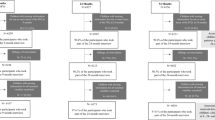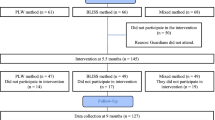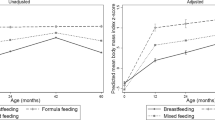Abstract
Background/Objectives:
To identify family and infant characteristics associated with timing of introduction of two food types: core foods (nutrient-dense) and non-core foods (nutrient-poor) in a population-based sample of mothers and infants.
Subjects/Methods:
Participants were 1861 mothers and infants from the Gemini twin birth cohort (one child per family). Family and infant characteristics were assessed when the infants were around 8 months old. Timing of introducing core and non-core foods was assessed at 8 and 15 months. As the distributions of timing were skewed, three similar-sized groups were created for each food type: earlier (core: 1–4 months; non-core: 3–8 months), average (core: 5 months; non-core: 9–10 months) and later introduction (core: 6–12 months; non-core: 11–18 months). Ordinal logistic regression was used to examine predictors of core and non-core food introduction, with bootstrapping to test for differences between the core and non-core models.
Results:
Younger maternal age, lower education level and higher maternal body mass index were associated with earlier core and non-core food introduction. Not breastfeeding for at least 3 months and higher birth weight were specifically associated with earlier introduction of core foods. Having older children was specifically associated with earlier introduction of non-core foods.
Conclusions:
There are similarities and differences in the characteristics associated with earlier introduction of core and non-core foods. Successful interventions may require a combination of approaches to target both food types.
This is a preview of subscription content, access via your institution
Access options
Subscribe to this journal
Receive 12 print issues and online access
$259.00 per year
only $21.58 per issue
Buy this article
- Purchase on Springer Link
- Instant access to full article PDF
Prices may be subject to local taxes which are calculated during checkout

Similar content being viewed by others
References
Illingworth RS, Lister J . The critical or sensitive period, with special reference to certain feeding problems in infants and children. J Pediatr 1964; 65: 839–848.
Freeman V, Van’t Hof M, Haschke F . Patterns of milk and food intake in infants from birth to age 36 months: the Euro-growth study. J Pediatr Gastroenterol Nutr 2000; 31 (Suppl 1), S76–S85.
Bolling K, Grant C, Hamlyn B, Thornton A Infant feeding survey 2005. A survey conducted on behalf of The Information Centre for health and social care and the UK Health Departments by BMRB Social Research. Department of Health, Social Services and Public Safety: London, United Kingdom, 2005.
Schiess S, Grote V, Scaglioni S, Luque V, Martin F, Stolarczyk A et al. Introduction of complementary feeding in 5 European countries. J Pediatr Gastroenterol Nutr 2010; 50: 92–98.
Cribb VL, Warren JM, Emmett PM . Contribution of inappropriate complementary foods to the salt intake of 8-month-old infants. Eur J Clin Nutr 2012; 66: 104–110.
Fox MK, Pac S, Devaney B, Jankowski L . Feeding infants and toddlers study: what foods are infants and toddlers eating? J Am Diet Assoc 2004; 104: s22–s30.
World Health Organisation. Infant and Young Child Nutrition. Fifty-fourth World Health Assembly. no. 54·2, WHO: Geneva, 2001.
Naylor AJ, Morrow AL Developmental Readiness of Normal full term Infants to Progress from Exclusive Breastfeeding to the Introduction of Complementary Foods: Reviews of the Relevant Literature Concerning Infant Immunologic, Gastrointestinal, Oral Motor and Maternal Reproductive and Lactational Development. Wellstart International and the LINKAGES Project Academy for Educational Development: Washington DC, 2001.
Wilson AC, Forsyth JS, Greene SA, Irvine L, Hau C, Howie PW . Relation of infant diet to childhood health: seven year follow up of cohort of children in Dundee infant feeding study. BMJ 1998; 316: 21–25.
Baker JL, Michaelsen KF, Rasmussen KM, Sørensen TI . Maternal prepregnant body mass index, duration of breastfeeding, and timing of complementary food introduction are associated with infant weight gain. Am J Clin Nutr 2004; 80: 1579–1588.
Sloan S, Gildea A, Stewart M, Sneddon H, Iwaniec D . Early weaning is related to weight and rate of weight gain in infancy. Child Care Hlth Dev 2008; 34: 59–64.
Ong KK, Loos RJF . Rapid infancy weight gain and subsequent obesity: systematic reviews and hopeful suggestions. Acta Paediatr 2006; 95: 904–908.
Schack-Nielsen L, Sørensen TI, Mortensen EL, Michaelsen KF . Late introduction of complementary feeding, rather than duration of breastfeeding, may protect against adult overweight. Am J Clin Nutr 2010; 91: 619–627.
Department of Health. Weaning and The Weaning Diet. no 45, HMSO: London, 1994.
United States Department of Agriculture (USDA). Infant Nutrition and Feeding: A Guide for Use in the WIC and CSF Programs. USDA: Washington, DC, 2008.
Bell AC, Kremer PJ, Magarey AM, Swinburn BA . Contribution of ‘noncore’ foods and beverages to the energy intake and weight status of Australian children. Eur J Clin Nutr 2005; 59: 639–645.
Rangan AM, Randall D, Hector DJ, Gill TP, Webb KL . Consumption of ‘extra’ foods by Australian children: types, quantities and contribution to energy and nutrient intakes. Eur J Clin Nutr 2008; 62: 356–364.
Smith A, Kellet E, Schmerlaib Y The Australian Guide to Healthy Eating. Commonwealth Department of Health and Family Services: Canberra, 1998.
Anderson AS, Guthrie C, Alder EM, Forsyth S, Howie PW, Williams FLR . Rattling the plate--reasons and rationales for early weaning. Health Educ Res 2001; 16: 471–479.
Wasser H, Bentley M, Borja J, Goldman DG, Thompson A, Slining M et al. Infants perceived as ‘fussy’ are more likely to receive complementary foods before 4 months. Pediatrics 2011; 127: 229–237.
Fewtrell MS, Lucas A, Morgan JB . Factors associated with weaning in full term and preterm infants. Arch Dis Child Fetal Neonatal Ed 2003; 88: F296–F301.
Lande B, Andersen LF, Baerug A, Trygg KU, Lund-Larsen K, Veierød MB et al. Infant feeding practices and associated factors in the first six months of life: the Norwegian infant nutrition survey. Acta Paediatr 2003; 92: 152–161.
Scott JA, Binns CW, Graham KI, Oddy WH . Predictors of the early introduction of solid foods in infants: results of a cohort study. BMC Pediatr 2009; 9: 60.
Skinner JD, Carruth BR, Bounds W, Ziegler P, Reidy K . Do food-related experiences in the first 2 years of life predict dietary variety in school-aged children? J Nutr Educ Behav 2002; 34: 310–315.
Wang Y, Bentley ME, Zhai F, Popkin BM . Tracking of dietary intake patterns of Chinese from childhood to adolescence over a six-year follow-up period. J Nutr 2002; 132: 430–438.
Birch LL, Fisher JO . Development of eating behaviors among children and adolescents. Pediatrics 1998; 101: 539–549.
Birch LL, Gunder L, Grimm-Thomas K, Laing DG . Infants’ consumption of a new food enhances acceptance of similar foods. Appetite 1998; 30: 283–295.
Beauchamp GK, Moran M . Dietary experience and sweet taste preference in human infants. Appetite 1982; 3: 139–152.
Cooke LJ, Wardle J, Gibson EL, Sapochnik M, Sheiham A, Lawson M . Demographic, familial and trait predictors of fruit and vegetable consumption by pre-school children. Public Health Nutr 2004; 7: 295–302.
Coulthard H, Harris G, Emmett P . Long-term consequences of early fruit and vegetable feeding practices in the United Kingdom. Public Health Nutr 2010; 13: 2044–2051.
Giovannini M, Riva E, Banderali G, Scaglioni S, Veehof SH, Sala M et al. Feeding practices of infants through the first year of life in Italy. Acta Paediatr 2004; 93: 492–497.
Norris FJ, Larkin MS, Williams CM, Hampton SM, Morgan JB . Factors affecting the introduction of complementary foods in the preterm infant. Eur J Clin Nutr 2002; 56: 448–454.
Grummer-Strawn LM, Scanlon KS, Fein SB . Infant feeding and feeding transitions during the first year of life. Pediatrics 2008; 122: S36–S42.
Koh GA, Scott JA, Oddy WH, Graham KI, Binns CW . Exposure to non-core foods and beverages in the first year of life: results from a cohort study. Nutr Diet 2010; 67: 137–142.
Johnson L, Van Jaarsveld CHM, Wardle J . Individual and family environment correlates differ for consumption of core and non-core foods in children. Br J Nutr 2011; 105: 950–959.
McGowan L, Croker H, Wardle J, Cooke LJ . Environmental and individual determinants of core and non-core food and drink intake in preschool-aged children in the United Kingdom. Eur J Clin Nutr 2012; 66: 322–328.
Van Jaarsveld CHM, Johnson L, Llewellyn C, Wardle J . Gemini: a UK twin birth cohort with a focus on early childhood weight trajectories, appetite and the family environment. Twin Res Hum Genet 2010; 13: 72–78.
Office for National Statistics. Review of the Registrar General on Births and Patterns of Family Building in England and Wales. National Statistics: Newport, UK, 2006.
Freeman JV, Cole TJ, Chinn S, Jones PR, White EM, Preece MA . Cross sectional stature and weight reference curves for the UK, 1990. Arch Dis Child 1995; 73: 17–24.
Cole TJ Software for LMS method: LMS Growth PC. http://homepage.mac.com/tjcole/FileSharing1.html.
Llewellyn CH, Van Jaarsveld CHM, Johnson L, Carnell S, Wardle J . Development and factor structure of the Baby Eating Behaviour Questionnaire in the Gemini birth cohort. Appetite 2011; 57: 388–396.
Carpenter J, Bithell J . Bootstrap confidence intervals: when, which, what? A practical guide for medical statisticians. Stat Med 2000; 19: 1141–1164.
Schachter S . Obesity and eating. Internal and external cues differentially affect the eating behavior of obese and normal subjects. Science 1968; 161: 751–756.
Johnson SL, Birch LL . Parents’ and children’s adiposity and eating style. Pediatrics 1994; 94: 653–661.
Geraghty SR, Pinney SM, Sethuraman G, Roy-Chaudhury A, Kalkwarf HJ . Breast milk feeding rates of mothers of multiples compared to mothers of singletons. Ambul Pediatr 2004; 4: 226–231.
Östlund Å, Nordström M, Dykes F, Flacking R . Breastfeeding in preterm and term twins—maternal factors associated with early cessation: a population-based study. J Hum Lact 2010; 26: 235–241.
Launer LJ, Forman MR, Hundt GL, Sarov B, Chang D, Berendes HW et al. Maternal recall of infant feeding events is accurate. J Epidemiol Commun Health 1992; 46: 203–206.
Griffiths LJ, Smeeth L, Hawkins SS, Cole TJ, Dezateux C . Effects of infant feeding practice on weight gain from birth to 3 years. Arch Dis Child 2009; 94: 577–582.
Tarrant R, Younger K, Sheridan-Pereira M, White M, Kearney J . Factors associated with weaning practices in term infants: a prospective observational study in Ireland. Br J Nutr 2010; 104: 1544–1554.
European Food Safety Authority (EFSA) Panel on Dietetic Products, Nutrition and Allergies (NDA). Scientific Opinion on the appropriate age for introduction of complementary feeding of infants. EFSA J 2009; 7: 1423.
Acknowledgements
The Gemini Study was funded by a grant from Cancer Research UK to Professor Wardle (C1418/A7974). Cancer Research UK had no role in the design and conduct of the study, collection, management, analysis and interpretation of data, and preparation, review or approval of the manuscript. We thank Dr David Boniface and Dr Chloe Taylor for their statistical support.
Author information
Authors and Affiliations
Corresponding author
Ethics declarations
Competing interests
The authors declare no conflict of interest.
Rights and permissions
About this article
Cite this article
Schrempft, S., van Jaarsveld, C., Fisher, A. et al. Family and infant characteristics associated with timing of core and non-core food introduction in early childhood. Eur J Clin Nutr 67, 652–657 (2013). https://doi.org/10.1038/ejcn.2013.63
Received:
Revised:
Accepted:
Published:
Issue Date:
DOI: https://doi.org/10.1038/ejcn.2013.63
Keywords
This article is cited by
-
Factors associated with early introduction of complementary feeding and consumption of non-recommended foods among Dutch infants: the BeeBOFT study
BMC Public Health (2019)
-
Obesogenic dietary intake in families with 1-year-old infants at high and low obesity risk based on parental weight status: baseline data from a longitudinal intervention (Early STOPP)
European Journal of Nutrition (2016)



